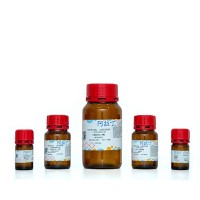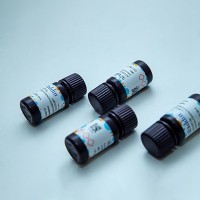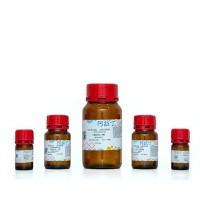Preparation of 2′‐Deoxy‐2′‐Methylseleno‐Modified Phosphoramidites and RNA
互联网
- Abstract
- Table of Contents
- Materials
- Figures
- Literature Cited
Abstract
The derivatization of nucleic acids with selenium is a useful approach to facilitate phase determination during three?dimensional structural analysis by X?ray crystallography. This unit describes (1) the synthesis and characterization of 2??deoxy?2??methylseleno (2??Se?methyl) nucleosides and their corresponding 3??O ?(2?cyanoethyl)?N ,N ?diisopropylphosphoramidite derivatives, (2) the site?specific incorporation of 2??Se?methyl ribonucleosides into oligoribonucleotides by chemical RNA solid?phase synthesis, and (3) the enzymatic ligation of Se?containing RNA oligonucleotides to produce a biologically relevant RNA sequence.
Keywords: selenium; RNA; chemical synthesis; phosphoramidites; enzymatic ligation; X?ray crystallography
Table of Contents
- Basic Protocol 1: Preparation of 2′‐Deoxy‐2′‐Methylselenouridine Phosphoramidite
- Alternate Protocol 1: Preparation of 2′‐Deoxy‐2′‐Methylselenocytidine Phosphoramidite
- Alternate Protocol 2: Preparation of 2′‐Deoxy‐2′‐Methylselenoadenosine Phosphoramidite
- Alternate Protocol 3: Preparation of 2′‐Deoxy‐2′‐Methylselenoguanosine Phosphoramidite
- Basic Protocol 2: Synthesis of RNA Oligonucleotides Containing 2′‐Methylseleno Nucleosides
- Basic Protocol 3: Deprotection, Purification, and Analysis of RNA Oligonucleotides Containing 2′‐Methylseleno Labels
- Basic Protocol 4: Enzymatic Ligation of Selenium‐Modified RNA Oligonucleotides Using T4 RNA Ligase
- Alternate Protocol 4: Enzymatic Ligation of Selenium‐Modified RNA Oligonucleotides Using T4 DNA Ligase
- Reagents and Solutions
- Commentary
- Literature Cited
- Figures
- Tables
Materials
Basic Protocol 1: Preparation of 2′‐Deoxy‐2′‐Methylselenouridine Phosphoramidite
Materials
Alternate Protocol 1: Preparation of 2′‐Deoxy‐2′‐Methylselenocytidine Phosphoramidite
Alternate Protocol 2: Preparation of 2′‐Deoxy‐2′‐Methylselenoadenosine Phosphoramidite
Alternate Protocol 3: Preparation of 2′‐Deoxy‐2′‐Methylselenoguanosine Phosphoramidite
Basic Protocol 2: Synthesis of RNA Oligonucleotides Containing 2′‐Methylseleno Nucleosides
Materials
Basic Protocol 3: Deprotection, Purification, and Analysis of RNA Oligonucleotides Containing 2′‐Methylseleno Labels
Materials
Basic Protocol 4: Enzymatic Ligation of Selenium‐Modified RNA Oligonucleotides Using T4 RNA Ligase
Materials
Alternate Protocol 4: Enzymatic Ligation of Selenium‐Modified RNA Oligonucleotides Using T4 DNA Ligase
|
Figures
-
Figure 1.15.1 Preparation of a 2′‐deoxy‐2′‐methylselenouridine phosphoramidite building block for RNA solid‐phase synthesis (see ). DMF, N , N ‐dimethylformamide; DMTr, 4,4′‐dimethoxytrityl. View Image -
Figure 1.15.2 Preparation of a 2′‐deoxy‐2′‐methylselenocytidine phosphoramidite building block for RNA solid‐phase synthesis (see ). DMAP, 4‐( N , N ‐dimethylamino)pyridine; DMF, N , N ‐dimethylformamide; DMTr, 4,4′‐dimethoxytrityl; TBAF, tetra‐ n ‐butylammonium fluoride; TBDMS, tert ‐butyldimethylsilyl; THF, tetrahydrofuran; TPS, 2,4,6‐triisopropylbenzenesulfonyl. View Image -
Figure 1.15.3 Preparation of a 2′‐deoxy‐2′‐methylselenoadenosine phosphoramidite building block for RNA solid‐phase synthesis (see ). DMAP, 4‐( N , N ‐dimethylamino)pyridine; DMTr, 4,4′‐dimethoxytrityl; TBAF, tetra‐ n ‐butylammonium fluoride; Tf, trifluoromethanesulfonyl; THF, tetrahydrofuran; TOM, [(triisopropylsilyl)oxy]methyl. View Image -
Figure 1.15.4 Preparation of a 2′‐deoxy‐2′‐methylselenoguanosine phosphoramidite building block for RNA solid‐phase synthesis (see ). DIAD, diisopropyl azodicarboxylate; DMAP, 4‐( N , N ‐dimethylamino)pyridine; DMF, N , N ‐dimethylformamide; DMTr, 4,4′‐dimethoxytrityl; NPE, 2‐(4‐nitrophenyl)ethyl; PPh3 , triphenylphosphine; TBAF, tetra‐ n ‐butylammonium fluoride; Tf, trifluoromethanesulfonyl; THF, tetrahydrofuran; TIPSCl2 , 1,3‐dichloro‐1,1,3,3‐tetraisopropyldisiloxane. View Image -
Figure 1.15.5 Enzymatic ligation of the adenine deaminase ( add ) adenine riboswitch aptamer domain ( Vibrio vulnificus ) with 2′‐methylseleno labels. Ligation of the 71‐nt RNA was achieved using T4 RNA ligase (0.20 U/µL; c RNA = 40 µM each strand; donor/acceptor = 1/1) at 21°C. DTT in ligation buffer is dithiothreitol. Analysis of the experiment by anion‐exchange HPLC, denaturating PAGE, and LC‐ESI‐MS. View Image -
Figure 1.15.6 Enzymatic ligation of the adenine deaminase ( add ) adenine riboswitch aptamer domain ( Vibrio vulnificus ) with 2′‐methylseleno labels. Ligation of the 71‐nt RNA was achieved using T4 DNA ligase and a 2′‐ O ‐methyl RNA splint oligonucleotide (0.25 U/µL; c RNA = 10 µM each strand; donor/acceptor/splint = 1/1/1) at 37°C. DTT in ligation buffer is dithiothreitol. ~undefinedSlight degradation of the product at 37°C was accepted for higher reaction rates). View Image
Videos
Literature Cited
| Literature Cited | |
| Adams, P.L., Stahley, M.R., Kosek, A.B., Wang, J., and Strobel, S.A. 2004. Crystal structure of a self‐splicing group I intron with both exons. Nature 430:45‐50. | |
| Arn, E.A. and Abelson, J. 1998. RNA ligases: Function, mechanism, and sequence conservation. In RNA Structure and Function (R.W. Simons and M. Grunberg‐Manago, eds.) pp. 695‐726. CSHL Press, Cold Spring Harbor, N.Y. | |
| Du, Q., Carrasco, N., Teplova, M., Wilds, C.J., Egli, M., and Huang, Z. 2002. Internal derivatization of oligoribonucleotides with selenium for X‐ray crystallography using MAD. J. Am. Chem. Soc. 124:24‐25. | |
| Ennifar, E., Carpentier, P., Ferrer, J.L., Walter, P., and Dumas, P. 2002. X‐ray‐induced debromination of nucleic acids at the Br K absorption edge and implications for MAD phasing. Acta Crystallogr. D Biol. Crystallogr. 58:1262‐1268. | |
| Gott, J.M., Wu, H., Koch, T.H., and Uhlenbeck, O.C. 1991. A specific, UV‐induced RNA‐protein cross‐link using 5‐bromouridine‐substituted RNA. Biochemistry 30:6290‐6295. | |
| Höbartner, C. and Micura, R. 2004. The chemical synthesis of selenium‐modified oligoribonucleotides and their enzymatic ligation leading to an U6 snRNA stem‐loop segment. J. Am. Chem. Soc. 126:1141‐1149. | |
| Höbartner, C., Rieder, R., Kreutz, C., Puffer, B., Lang, K., Polonskaia, A., Serganov, A., and Micura, R. 2005. Combined chemical and enzymatic syntheses of RNAs with up to 100 nucleotides containing site‐specific 2′‐Se‐methyl labels for use in X‐ray crystallography. J. Am. Chem. Soc. 127:12035‐12045. | |
| Moroder, H., Kreutz, C., Lang, K., Serganov, A., and Micura, R. 2006. Synthesis, oxidation behavior, crystallization and structure of 2′‐methylseleno guanosine containing RNAs. J. Am. Chem. Soc. 128:9909‐9918. | |
| Pitsch, S., Weiss, P.A., Jenny, L., Stutz, A., and Wu, X. 2001. Reliable chemical synthesis of oligoribonucleotides (RNA) with 2′‐O‐[(triisopropylsilyl)oxy]methyl (2′‐O‐TOM) protected phosphoramidites. Helv. Chim. Acta 84:3773‐3795. | |
| Serganov, A., Keiper, S., Malinina, L., Tereshko, V., Skripkin, E., Höbartner, C., Polonskaia, A., Phan, A.T., Wombacher, R., Micura, R., Dauter, Z., Jaschke, A., and Patel, D.J. 2005. Structural basis for Diels‐Alder ribozyme catalyzed carbon‐carbon bond formation. Nat. Struct. Mol. Biol. 12:218‐224. | |
| Teplova, M., Wilds, C.J., Wawrzak, Z., Tereshko, V., Du, Q., Carrasco, N., Huang, Z., and Egli, M. 2002. Covalent incorporation of selenium into oligonucleotides for X‐ray crystal structure determination via MAD: Proof of principle. Biochimie 84:849‐858. | |
| Wilds, C.J., Pattanayek, R., Pan, C., Wawrzak, Z., and Egli, M. 2002. Selenium‐assisted nucleic acid crystallography: Use of phosphoroselenoates for MAD phasing of a DNA structure. J. Am. Chem. Soc. 124:14910‐14916. | |
| Xu, Y. and Sugiyama, H. 2004. Highly efficient photochemical 2′‐deoxyribonolactone formation at the diagonal loop of a 5‐iodouracil‐containing antiparallel G‐quartet. J. Am. Chem. Soc. 126:6274‐6279. | |
| Zeng, Y. and Wang, Y. 2004. Facile formation of an intrastrand cross‐link lesion between cytosine and guanine upon pyrex‐filtered UV light irradiation of d(BrCG) and duplex DNA containing 5‐bromocytosine. J. Am. Chem. Soc. 126:6552‐6553. |






